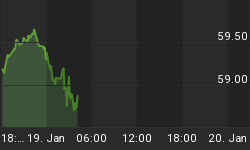Below is an extract from a commentary originally posted at www.speculative-investor.com on 19th November 2006.
Are rising nominal long-term interest rates bullish or bearish for gold-related investments?
As a matter of fact neither, because gold is influenced by changes in REAL interest rates and interest rate spreads. Specifically, falling real interest rates are bullish for gold, as are increases in the spreads between long-term and short-term interest rates. It's therefore possible for a bullish (or bearish) interest rate environment -- as far as gold is concerned, that is -- to be associated with rising OR falling long-term interest rates. For example, gold-related investments fared very well in parallel with rising long-term interest rates during 1977-1980 and in parallel with falling long-term interest rates during 2001-2003.
Having said that, ever since gold and the dollar were formally de-linked in 1971 a 'long' position in gold has, in effect, been a bet against official money in general and the US dollar in particular, with bull markets in gold being fueled by falling confidence in the dollar and bear markets in gold being fueled by rising confidence in the dollar. And falling confidence in the dollar tends to be associated with the ramping-up of inflation expectations, which, in turn, should force long-term interest rates upward. In theory, therefore, a secular (generational) rise in the prices of gold-related investments should occur alongside a secular rise in bond yields whereas a secular fall in the prices of gold-related investments should occur alongside a secular fall in bond yields.
The historical performance record since the early days of the current monetary system validates this theory, but with an interest twist: at important turning points gold-related investments LEAD bond yields.
The lead-lag relationship between gold-related investments and long-term interest rates is illustrated by the following chart comparison of the 10-year Treasury Note yield and the Barrons Gold Mining Index (BGMI). With the 10-year yield lagged by one year it is apparent that major and intermediate-term turning points in the BGMI generally correspond quite closely with similar turning points in the long-term interest rate.

The above chart's overarching message is that rising nominal long-term interest rates may or may not be bullish for gold-related investments, but rising prices for gold-related investments are most definitely a bullish omen for long-term interest rates (a bearish omen for bond prices). Therefore, if gold is in a secular upward trend then so are long-term interest rates unless the relationship depicted on the above chart has recently changed.
Which begs the question: could the relationship depicted on the above chart have changed? In particular, could the massive demand for government bonds emanating from Asian central banks as part of what Donald Coxe has labeled "The Great Symbiosis" (the unwritten agreement that the central banks of China and Japan will absorb huge quantities of US bonds with the aim of propping up the US dollar and suppressing US interest rates, thus paving the way for US consumers to buy more of the things made in China and Japan) prevent bond yields from following gold higher during the current cycle?
At this stage all we can say is that the relationship between bonds and gold that has worked so reliably over the past few decades doesn't appear to have changed. The mid-2003 upward reversal in bond yields occurred later than would have been predicted by a literal interpretation of the above chart, but it's not reasonable to expect a long-term relationship such as this to predict major turning points to within a few months. The point is that DESPITE the phenomenal buying of US bonds by Asian central banks the trend in bond yields reversed higher roughly on cue.
















